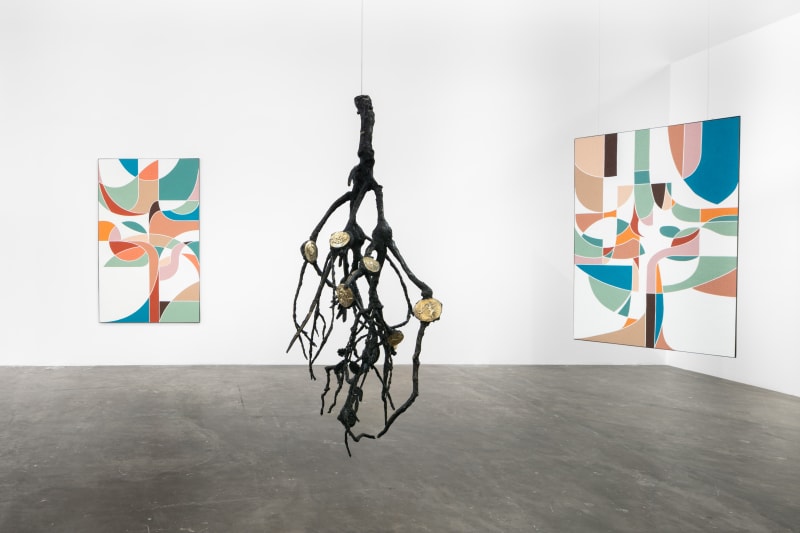Mimosa tenuiflora Naufus Ramírez-Figueroa
Past exhibition
Overview
Mendes Wood DM is pleased to present the first solo exhibition of the artist Naufus Ramírez-Figueroa (Guatemala, 1978) in São Paulo. The exhibit, entitled Mimosa Tenuiflora, brings together video works, paintings, and sculptures – scenarios pervaded by an atmosphere of dream and fantasy, yet communicating an awaken world. Mimosa tenuiflora, named after a tree of healing properties whose habitat comprises South and Central Americas, mainly ponders over the artist’s most recent productions, conveying themes related to ecology and to the symbiosis between humans and nature.
Historically used by traditional communities of Central America for the treatment of skin diseases –therefore, called “tree of skin” – Mimosa tenuiflora has drawn a more notorious acknowledgment after the earthquake of 1985, which devastated Mexico City. Arising from recountings made then, Ramírez-Figueroa recalls the broad use of the plant alternatively to Western medicine treatments. Also applied for therapeutic purposes in religious rituals of South America – as in the usage of its leaves for Jurema, a Brazilian religious practice of indigenous heritage –, the tree that gives name to this exhibition indicates the artist’s interest in further investigating a wider concept of skin and cure.
The set of paintings in the exhibit, made in acrylic on wood, receive the title Between tree and skin and derive from the very concept of skin care stressed by the artist. Above all, Ramírez-Figueroa is aware of how nature – especially Mimosa tenuiflora – is able to compensate for the lack of care human beings devote to their own body and their surroundings. The skin is too a focal point in a wider scope of the artist’s work: the states of transfiguration. Ramírez-Figueroa often resorts to fantasy and allegory to transform ordinary images and objects.
In the video Linnaeus in Tennebris, a result of the installation and performance lead by the artist in the CAPC Museum in Bordeaux, Ramirez-Figueroa devises a sort of space resembling a banana plantation, which alludes to the botanical classification systems adopted by the scientific community – namely, the botanist Carl Linnaeus – during the European Illuminism. Here, the artist reflects upon the classification systems that endorse power hierarchies, and the forced migration upheld by a colonialist logic until today. With the advent of scientific expeditions at the time, people from Guatemala and other regions of Central America were forced to migrate to the Caribbean due to the dominant cultivation of certain plants. The artist interrelates the outcomes of this process: plants migration is also the history of human beings’ forced migration.
The work of Ramírez-Figueroa thinks of complex trajectories and memories as a whole – also an aspect in the Mimosa tenuiflora examination and its relation to the skin. The sculpture entitled A Mirror Tree strengthens this symbiosis – tree as a mirror and as an entity, capable of weaving the relations binding skin and nature. The artist goes through this fabric and brings it to the world of the visible – in which the skin is a synthesis of contact, transformation, and cure.
Historically used by traditional communities of Central America for the treatment of skin diseases –therefore, called “tree of skin” – Mimosa tenuiflora has drawn a more notorious acknowledgment after the earthquake of 1985, which devastated Mexico City. Arising from recountings made then, Ramírez-Figueroa recalls the broad use of the plant alternatively to Western medicine treatments. Also applied for therapeutic purposes in religious rituals of South America – as in the usage of its leaves for Jurema, a Brazilian religious practice of indigenous heritage –, the tree that gives name to this exhibition indicates the artist’s interest in further investigating a wider concept of skin and cure.
The set of paintings in the exhibit, made in acrylic on wood, receive the title Between tree and skin and derive from the very concept of skin care stressed by the artist. Above all, Ramírez-Figueroa is aware of how nature – especially Mimosa tenuiflora – is able to compensate for the lack of care human beings devote to their own body and their surroundings. The skin is too a focal point in a wider scope of the artist’s work: the states of transfiguration. Ramírez-Figueroa often resorts to fantasy and allegory to transform ordinary images and objects.
In the video Linnaeus in Tennebris, a result of the installation and performance lead by the artist in the CAPC Museum in Bordeaux, Ramirez-Figueroa devises a sort of space resembling a banana plantation, which alludes to the botanical classification systems adopted by the scientific community – namely, the botanist Carl Linnaeus – during the European Illuminism. Here, the artist reflects upon the classification systems that endorse power hierarchies, and the forced migration upheld by a colonialist logic until today. With the advent of scientific expeditions at the time, people from Guatemala and other regions of Central America were forced to migrate to the Caribbean due to the dominant cultivation of certain plants. The artist interrelates the outcomes of this process: plants migration is also the history of human beings’ forced migration.
The work of Ramírez-Figueroa thinks of complex trajectories and memories as a whole – also an aspect in the Mimosa tenuiflora examination and its relation to the skin. The sculpture entitled A Mirror Tree strengthens this symbiosis – tree as a mirror and as an entity, capable of weaving the relations binding skin and nature. The artist goes through this fabric and brings it to the world of the visible – in which the skin is a synthesis of contact, transformation, and cure.
Works
Installation Views







